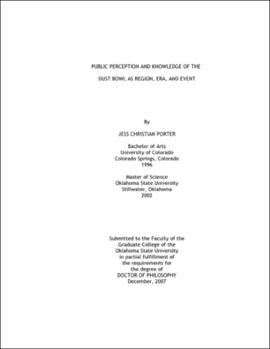| dc.contributor.advisor | Cordova, Carlos E. | |
| dc.contributor.author | Porter, Jess Christian | |
| dc.date.accessioned | 2013-11-26T08:24:07Z | |
| dc.date.available | 2013-11-26T08:24:07Z | |
| dc.date.issued | 2007-12 | |
| dc.identifier.uri | https://hdl.handle.net/11244/6773 | |
| dc.description.abstract | Scope and Method of Study: This dissertation assessed the general public's understanding of the Dust Bowl as a region, era, and event for the purpose of illuminating spatial and demographic variations in the knowledge base. A questionnaire was administered to 372 voluntary participants in 93 counties of an area that has been defined as the Dust Bowl region by academic consensus. Questionnaire responses were analyzed qualitatively and quantitatively via a database and geographic information system. Over 100 maps were produced to document the findings. | |
| dc.description.abstract | Findings and Conclusions: The study found distinctive differences in respondent knowledge and perceptions as a result of spatial and demographic variation. In general, respondents from Kansas, and particularly northwest Kansas, exhibited a depth and breadth of knowledge of the Dust Bowl that exceeded that of respondents from other areas. Reponses from this portion of the study area also exhibited the highest level of association with the academic consensus regarding the Dust Bowl. On the other hand, respondents from the southern half of the study area, particularly those from Texas, displayed less association with the academic record. Across the study area, oldest respondents displayed knowledge that was much more nuanced than their younger respondent counterparts. An erosion of knowledge regarding all three Dust Bowl concepts was noted with decreasing age. Factors beyond personal experience that were most indicative of high levels of Dust Bowl knowledge were relationships with Dust Bowl survivors and a place of birth within the study area. With Dust Bowl survivors entering the final years of their lives, and a significant reduction in the number of voices to pass on their experiences with the precarious Plains environment, it is becoming imperative to augment educational resources on the topic. Respondents of all ages expressed support for enhanced Dust Bowl educational resources, such as a dedicated museum or interactive educational website. In a time of rapidly changing climate, diminishing groundwater resources and emigration into the region by persons largely unfamiliar with the history of the human-environment dynamic of the region, greater familiarity with this keystone event of human ecology is essential. | |
| dc.format | application/pdf | |
| dc.language | en_US | |
| dc.rights | Copyright is held by the author who has granted the Oklahoma State University Library the non-exclusive right to share this material in its institutional repository. Contact Digital Library Services at lib-dls@okstate.edu or 405-744-9161 for the permission policy on the use, reproduction or distribution of this material. | |
| dc.title | Public perception and knowledge of the Dust Bowl as region, era, and event | |
| dc.contributor.committeeMember | Comer, Jonathan C. | |
| dc.contributor.committeeMember | Lightfoot, Dale | |
| dc.contributor.committeeMember | Finchum, George Allen | |
| dc.contributor.committeeMember | Logan, Michael F. | |
| osu.filename | Porter_okstate_0664D_2497.pdf | |
| osu.accesstype | Open Access | |
| dc.type.genre | Dissertation | |
| dc.type.material | Text | |
| dc.subject.keywords | dust bowl | |
| dc.subject.keywords | great plains | |
| dc.subject.keywords | region | |
| dc.subject.keywords | cultural geography | |
| dc.subject.keywords | environmental perception | |
| dc.subject.keywords | human-environment interaction | |
| thesis.degree.discipline | Geography | |
| thesis.degree.grantor | Oklahoma State University | |
